| PROPORTIONS IN PICTURE FRAMING |
 |
|
Ever wondered about the "rules" to visually pleasing picture frame displays? While it might be fun to experiment once in awhile, sometimes it's useful to follow a template that practically guarantees a good result.
This article considered the proportion guidelines of frame, mat, and image that turn out a great wall hanging that flatters the space, the image, and the accessories.
For more information, check out our article on Choosing the Best Mat Size.
|
SUMMARY
In this article, we will discuss the following concepts and how each can positively or negatively impact your final framed display.
| Aspect Ratio |
Golden Ratio |
Mat Sizes |
Frame Sizes |
| Used to determine the alternate sizes your photograph can be resized to without stretching or flattening the image. |
Used for centuries by artists and architects, this ratio is considered aesthetically sound. In picture framing, it can be used to determine a visually pleasing mat to photo ratio. |
Traditional "correct" mat sizes differ slightly from the golden ratio calculations. They are applied by some framers, while others opt for freer choices. |
The frame size impacts the visual effect of a framed artwork as much as the mat size. Certain guidelines will keep the border from overpowering the image. |
|
| ASPECT RATIO
|
 |
|
One of the important mathematical concepts to understand when it comes to printing and framing photographs is "aspect ratio." While not a complicated equation, it does tend to cause some confusion.
Aspect ratio is the comparison of height and width of a two dimensional surface. It may be most familiar to you in reference to tv screens. If you've ever had a stretched out or squished up image on your screen, you probably had to fiddle with the aspect ratio to fix it. Though most of us just flick through the options until the picture looks right, there is some rhyme and reason to it.
Why does this matter in photography and printing? It comes into play when you want to resize your image. If you have a 16 x 20" image, you can't resize it to 10 x 14" or 20 x 30" and have it remain properly proportioned. 20 x 25" works, but how do you figure that out?
Well, you can use Photoshop and simply resize one dimensions. The other dimension will automatically correct. But if you don't have your digital editor handy, you can figure it out with nothing more than a calculator.
Examples:
- 10x10" Aspect Ratio: 10/10=1; aspect ratio = 1:1 (all square images)
- 16 x 20" Aspect Ratio: 20/16=1.25; aspect ratio = 1:1.25
- 20 x 24" Aspect Ratio: 24x20=1.2; aspect ratio = 1:1.20
Now you can resize your image by multiplying your desired width by the right-hand side of the ratio. These aspect ratios aren't made up of pretty, whole numbers like 4:3, but they can be. Multiply both sides of example 1 by 4 and you get a nice, clean ratio of 4:5.
So, if you have a 16 x 20" image and you want it to be 20" wide, you multiply 20 x 1.25. The new image size will be 20 x 25". Other options include 8 x 10" and 32 x 40". Remember, the dimensions don't have to be whole numbers. You can also print images that are 19 x 23-3/4" or 14 x 17-1/2".
|
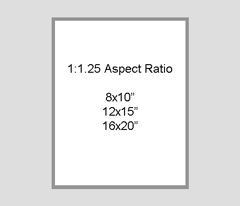
1:1.25 Aspect Ratio
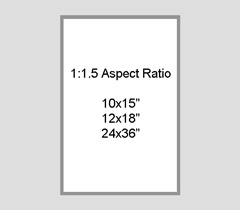
1:1.5 Aspect Ratio
|
| GOLDEN RATIO
|
 |
|
Not to be confused with aspect ratio, golden ratio is represented by the Greek letter phi (Φ), and is in effect if: "the ratio of two quantities is the same as the ratio of their sum to the larger of the two quantities." Mathematically, this translates to the equation shown at right. Phi is equal to 1.618 (and many more decimal points).
So why does this matter in regards to your picture frame? Well, the golden ratio is often considered the most aesthetic visual proportions. Artists like Salvador Dali would create their paintings following this rule. Perhaps the main reason for the respect it garners is the vast number of ways it manifests in nature. (For instance: spiral arrangements in plant leaves.)
You can determine one version of "the best" art display by choosing a frame or a picture mat that achieves the golden ratio in relation to the photograph. Rather than force you to do the math yourself, the following table identifies mat or frame sizes for different picture sizes, following this equation. You will notice, however, some sizes differ from the suggested mat widths in the following section.
PICTURE SIZE
(INCHES) |
BORDER WIDTH
(INCHES) |
| 5x7 |
0.8 |
| 8x10 |
1.2 |
| 9x12 |
1.4 |
| 11x14 |
1.7 |
| 16x20 |
2.4 |
| 20x24 |
3 |
The Golden Rectangle (pictured at right) is a geometric manifestation of the golden ratio. According to the Golden Rectangle Wikipedia Page, a golden rectangle is created by following these four steps, using a ruler and compass:
- Construct a simple square.
- Draw a line from the midpoint of one side of the square to an opposite corner.
- Use that line as the radius to draw an arc that defines the height of the rectangle.
- Complete the golden rectangle.
|
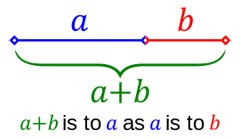
Golden Ratio equation
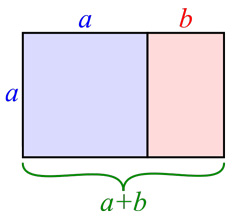
Golden Rectangle
|
| MAT SIZE ACCORDING TO TRADITION
|
 |
|
There used to be very precise rules on the "perfect" mat size. While today these laws are bent and broken with style and skill, there are still many people who would rather just be told the ideal width, and that's just fine. The chart below outlines the mat size widely accepted as the best for various artwork dimensions.
Do note, however, this table does not take into consideration the width of the frame. You could select the perfect mat width for your photograph, but if the frame is too large or too small, all that careful consideration will have been for nothing. If you planning to purchase and frame and a mat, use this guide to select the mat, then choose a complementary frame that suits the mat size. We'll discuss that briefly next.
Despite the rules shown below, it's important to note that many professional framers will recommend avoiding mats less than 2" wide.
PICTURE SIZE
(INCHES) |
BORDER WIDTH
(INCHES) |
| 5x7 |
1.5-1.75 |
| 8x10 |
1.75 |
| 9x12 |
1.75-2 |
| 11x14 |
2 |
| 16x20 |
2.25 |
| 20x24 |
2.75-3 |
|
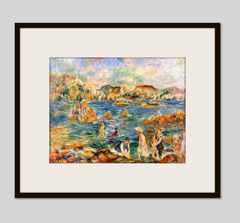
The classic frame to mat to image design
|
| FRAME PROPORTIONS
|
 |
THE FRAME FACE
Traditionally, most of us are aware: the larger the artwork or photograph, the wider the picture frame face. This is a basic guideline; these days many decorators and artists are choosing to frame small pieces in frames with faces nearly as wide as the width of the image.
Perhaps more important than the photograph to frame ratio is the frame to mat ratio. Whenever possible, avoid pairing a mat with a frame the same size or larger. As a general rule, your mat should always be 1.5 times as wide as your frame, or wider. If the mat is smaller than the frame, you run the risk of the artwork appearing stuffed into the frame. If the mat and the frame are the same size, both pieces vie for attention and the intended focus - the photograph - is lost in the battle.
THE FRAME SIZE
Don't be afraid of large frame sizes (with narrow or wide faces) for small images. Wide mats (3, 4, or even 5 inches) are quite popular these days. Depending on the artwork and the style of frame, that berth of white space may even be the intended focus of the display, with the image just there to draw the eye inward.
|
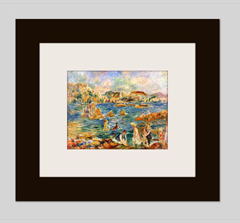
The mat and frame are the same size
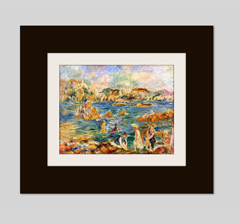
The mat is larger than the frame
|
| USEFUL LINKS
|
 |
The links below will redirect you to different articles and order pages on our website that may be useful when you are choosing a picture frame, mat, or print.
RESOURCES
|

|
| PRODUCT ORDER PAGES
|
 |
|
|
 |
Custom Wood Frames:
Our quality framing solutions include a wide range of custom-made wood 7 METAL frames in various styles and sizes.
To start Click here. |
|
 |
Fine Art Paper Printing:
We offer affordable Fine Art Inkjet Printing as a custom service for artists, commercial photographers and anyone else concerned with producing top-quality archival prints.
To start Click here. |
|
|
If you have any questions about the best mat or frame size for your artwork or photograph, or enquiries about our other services or products, don't hesitate to contact us. Our knowledgeable staff is always happy to assist with answers, advice, or suggestions.
|
| Matboard FAQs: |
 |
Q1 : Does my artwork need a mat?
Whether or not to add a mat to your image is entirely up to you. If you intend to sell the artwork or pass it down as a family heirloom, an acid-free mat is a good idea to protect the image from the condensation that may occur on the glass. But if you are simply framing family photographs or an art print, the mat is a purely aesthetic option.
Order online:
Custom-cut matboards
Full sheet, 32x40" matboard
Q2 : What color is your whitest white?
We offer many shades of white mat board. Crystal White is our brightest white.
Order online:
Custom-size mats
Full, 32x40" matboards
Q3 : What is backing board?
Backing board is used to back or mount prints inside a frame.It is slightly thinner than a 4-ply matboard. It
Order online: Backing Boards
Q4 : Do you sell full sheets (32 x 40)?
We currently sell full matboard sheets (32x40") in certain colors.
Order online:
Full, 32x40" matboards
Q5 : What is the purpose of a mat?
Matting is the border that surrounds your art within the frame. Visually, the mat boards provide "breathing room" from any distractions on the surrounding wall including the frame. The other usage of Mat is separating the artwork from the plexi or glass.
Q6 : Should I get an acid-free mat or a regular mat?
Acid- and lignin-free mats guarantee no artwork degradation will occur because of the mat for hundreds of years. If you plan to sell your piece or show it in a gallery, a Museum core mat board is advisable. However, if you are simply framing an inexpensive piece or a print to show in your home, you should be fine with a regular mat.
Even our regular mats are treated with calcium carbonate to keep them acid-neutral for 100 years.
Q7 : How do I choose the best color mat?
A colored mat is a great way to enhance or draw out certain sections of your artwork. At the same time, a colored mat can have a detrimental effect if it does not flatter the artwork colors. Try laying different mats on top of your artwork to help you decide. If no color seems to fit, a mat in one of our many shades of white is always a good choice.
Order online:
Custom-size mats
Q8 : How much of my image will the mat cover?
The mat will cover 1/8" to 1/4" on each side of your image. This overlap is essential to ensure your artwork remains behind the mat and does not fall through. We recommend the default overlap of 1/4", but if your artwork has many important details along the edges that you do not want obscured, we can cut the mat to have an 1/8" overlap.
If your image has a white border around it, do not cut this off prior to matting. We can minimize the amount of overlap on the actual image if there is enough space around the edge.
Q9 : What is the difference between regular, conservation, and museum mat boards?
Regular mat boards are made from wood pulp, treated with an acid-neutralizer that minimizes negative reactions between the mat and artwork. They are our least expensive mat board.
Conservation mat boards have a core of acid- and lignin-free cotton, and a facing of wood pulp paper. They protect the artwork from acid burn and degradation for at least 100 years, and have a mid-range cost.
Museum core mat boards are made entirely of cotton rag paper. They are guaranteed to have no adverse reaction with artwork for hundreds of years. Museum mat boards are the most expensive and the best quality.
Q10 : Do you have more mat options than are on your website?
We do carry other options for mat boards, but they need to be ordered in, and this can delay your order. Please contact us if you require a different mat.
Q11 : How wide should my mat be?
The width of the mat is up to the customer, but we can provide some general guidelines.
For average sized artwork (about 11x14" to 30x20"), the common mat width is 2". If you artwork is smaller, you might consider a 1.75 or 1.5" mat. If you artwork is very large, a 3" or 4" mat may be necessary to ensure an aesthetically pleasing ratio.
Please see our article Measuring for Mats for more information.
Q12 : How do I order a mat board with my frame?
When you select the frame size to order, you will see an option to add "mats" to your order. When you select this, you can choose your mat color. The mat width is the thickness on one side, between the frame and the artwork (generally about 2"). If you are selecting two mats, the reveal is the amount of the bottom mat that will show between the artwork and the top mat.
Q13 : Do you carry different thicknesses of mat boards?
We can make your order with 8 ply mat boards in basic colors, however we do not keep them in stock, so ordering them may delay your order by a few days. We offer a wide selection of colors in the regular 4 ply thickness, and a double mat is a good option if you require a thicker division between plexiglass and image.
Q14 : Can I come into your store to choose a matboard?
If you are located in the Vancouver area, you are welcome to stop by our store and go through our mat samples. Unfortunately, we are an online business and do not have storefronts in other locations.
Q15 : Can I get a mat larger than 32x40 inches?
Unfortunately, our mat boards do not come in a larger size than 32 x 40, so we are unable to accommodate oversize mat orders. Have you considered having your artwork printed with a colored border?
Another option for larger artwork is to purchase a linen liner. Because these are custom made like picture frames, you can order larger sizes. Please note, however, that liners are thicker than matboards, and may require a frame with a deeper rabbet.
Order online: Full, 32x40" Matboards
Q16 : What brand are your mat boards?
Our mat boards are made by Peterboro. This Canadian company has been in the paper-making business since 1902, and their products are manufactured in and distributed from Canada.
Q17 : What is the difference between mat, matt, and matte?
Though "mat" is the most widely recognized spelling, all three words mean the same thing: a rigid paper border that divides the image from the glass and the frame.
"Matte" or "matt" may also refer to a smooth, non-reflective finish.
Q18 : How many different matboard colors do you carry?
We stock 50 regular matboard colors, as well as about 30 conservation and 18 museum core colors. However, we are able to order any color you would like. Contact us if you do not see the color you want on the website. Please remember that ordering a mat we do not have in stock will delay your order a few days.
Order online, or view our full selection in stock: Matboards
Q19 : What is the mat offset?
The offset is the amount that your mat is smaller than your image. This slight overlap ensures your artwork will not fall through your mat. However, you do not need to factor this measurement into your calculations - we will automatically cut your matboard 1/8" to 1/4" smaller on each side than your artwork size.
Q20 : What calculations do I need for ordering a mat?
All you need to know is the size of your artwork, and the width of the mat border (usually about 2" on each side). Both these amounts can be entered in our online form when you place your order.
We will do all other calculations for you, such as the mat offset and the total frame size.
Please see our article, Measuring for Mats for more information.
Q21 : What is the mat window?
The mat window, or mat opening, is the space between the two inner edges of the mat - the hole through which your artwork will show. The mat window is generally 1/4" to 1/2" smaller than your artwork vertically and horizontally. This allows for the mat offset, which overlaps your image 1/8" or 1/4" on each side, keeping the art from falling through the mat.
Q22 : Can I order Custom Cut Frame MatBoards?
Yes, to order click here: Custom Cut MatBoards
Q23 : What is the fifference between 4 ply or 8 ply matbaords?
Ply is the thickness of the matboard. The most common thickness used is 4 ply (around 1/16th of an inch) and double thick matboards are 8 ply or roughly 1/8 inch thick. The higher the number, the thicker and more rigid the board. Ply means a thickness or layer.
|
|
| If you don't find the answer you're looking for here, please contact us. |
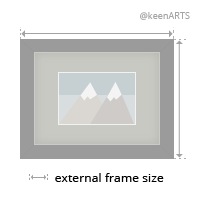
Front Side |
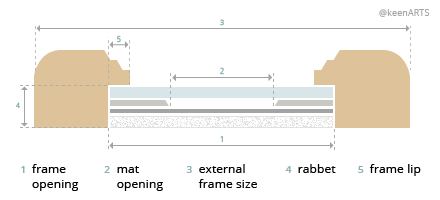
Picture framing terms |
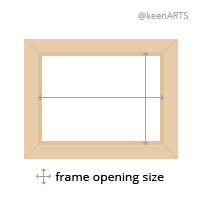
Back Side |
| MatBoard Guide: |
 |
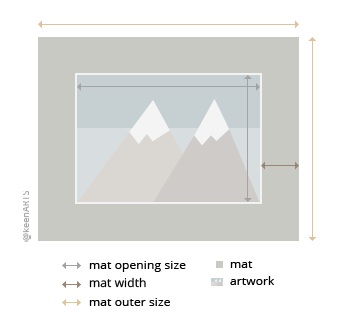 Single Matboard Sample |
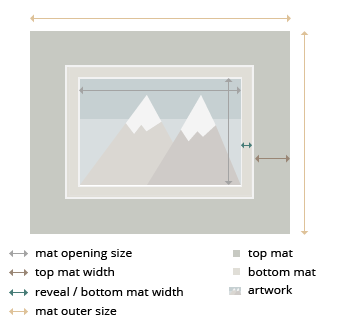 Double Matboard Sample |
|
Terms:
Top Mat: Top layer of a double mat; It has a larger window, which allows a small border of the bottom mat, called the reveal, to be shown.
Bottom Mat: Optional second layer of matboard used in double matting; The window opening of the bottom mat surrounds the artwork.
Reveal: Width of the bottom mat, normally 1/4", 3/8" & 1/2"
Mat Outer Size: Also known as frame opening size, matches the plexi glass or backing size of the picture frame
Artwork Size: The exact size of the artwork!
Mat Opening Size: Size of the matboard window cut out
|
|
|
Our informative articles on MatBoards:
Choosing the Best Mat Size The article offers helpful tips on selecting the appropriate mat size for your artwork.
Measuring for Mats All about Mat Outer Size, Artwork Size and Mat Opening Size
Choosing Mat Color How to select the best colors of mat fo ryour artwork
All About Mats The article discusses the different materials and attributes of picture framing mats and more!
|
|
© 2002-2024 - KeenART Media Ltd.
|
|
| |
|

